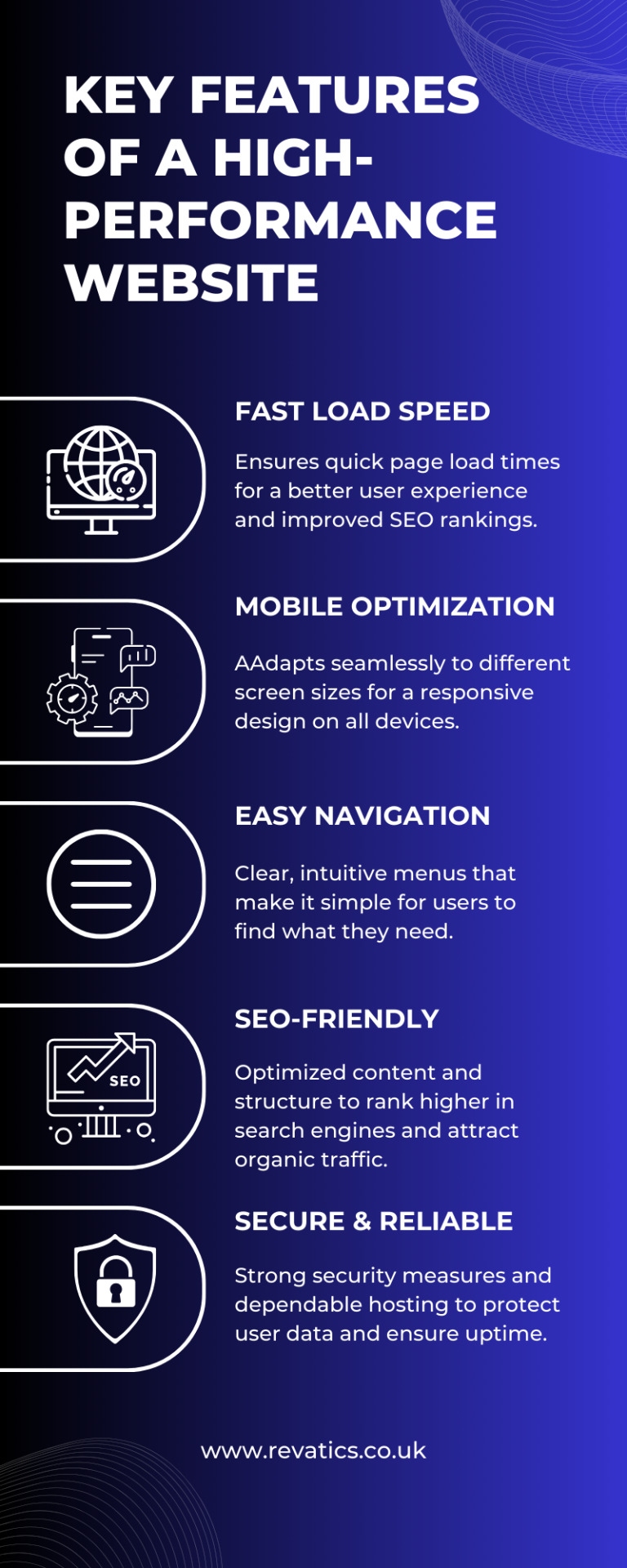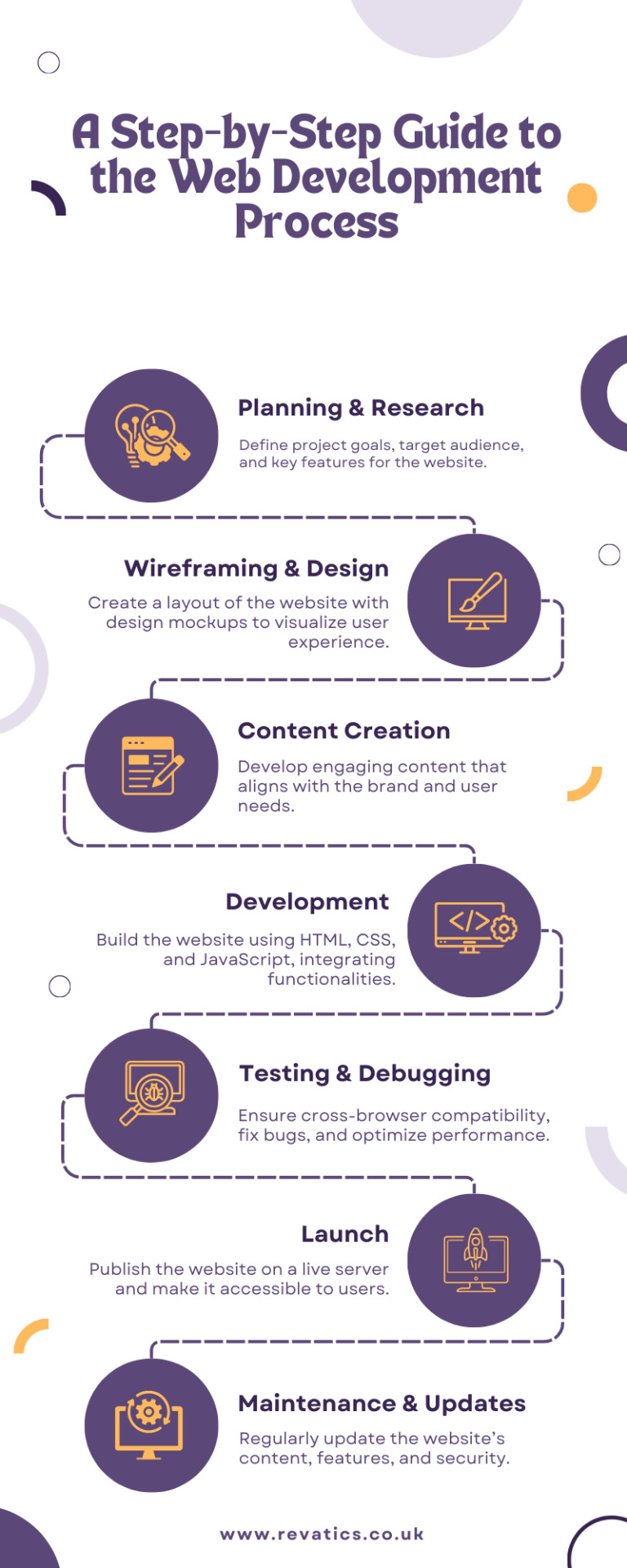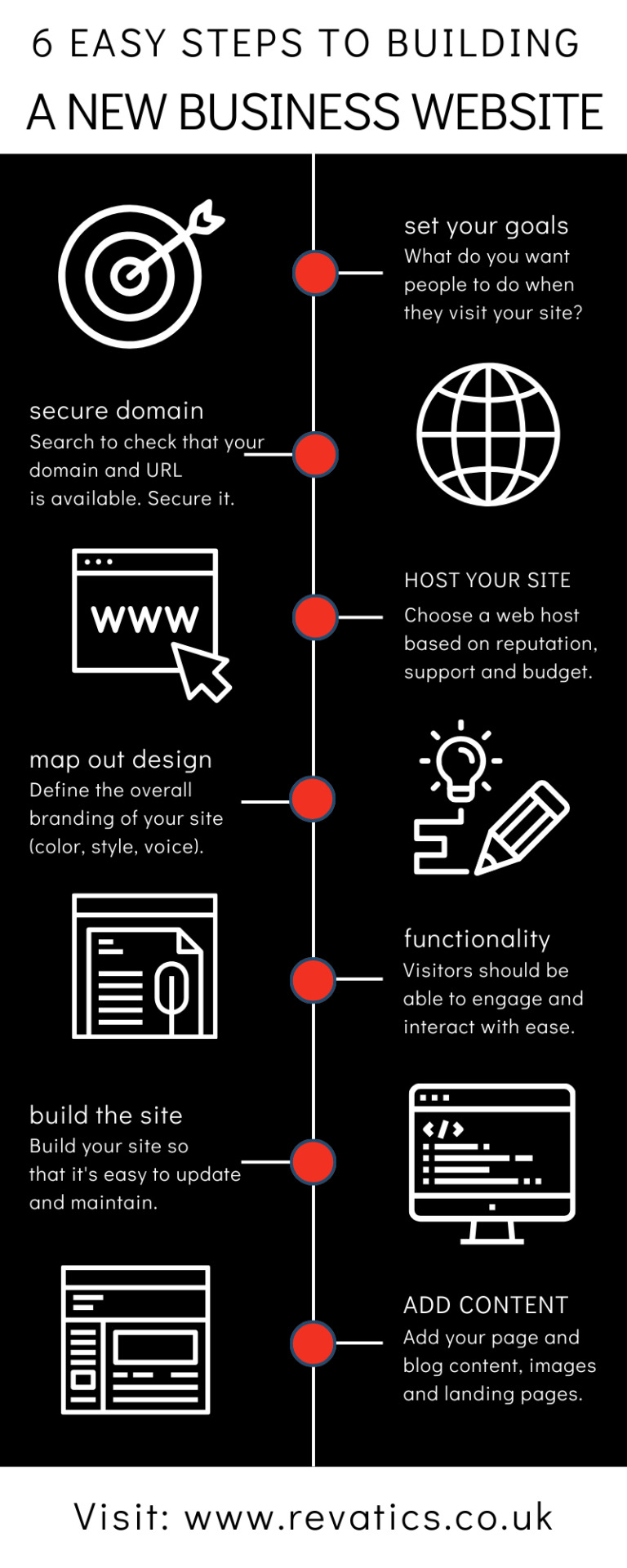Revatics is a leading web development company in UK, renowned for crafting innovative digital solutions that drive business success. With a dedicated team of experts, Revatics excels in delivering custom web development, seamless e-commerce platforms, and cutting-edge mobile applications. Our commitment to excellence and client satisfaction ensures that each project is tailored to meet the unique needs of our clients. We leverage the latest technologies and best practices to create engaging, user-friendly websites that enhance brand presence and boost online performance. At Revatics, we transform ideas into impactful digital experiences, setting new standards in the web development industry.Visit: https://www.revatics.co.uk/
Don't wanna be here? Send us removal request.
Text

Key Features of a High-Performance Website
Boost your website's performance with these 5 key features: fast load speed, mobile optimization, easy navigation, SEO-friendliness, and top-notch security. Improve user experience, rankings, and reliability! For more information Visit us today!
0 notes
Text
The Role of AI in Driving Digital Transformation

In the past few years the phrase digitalization has been haunting various sectors. Organizations are becoming more aware of the need to change as per the virtual requirements owing to the changing expectations of customers, technology growth and the need to improve business processes.
The major component that drives this change is that AI is a fundamental enabling technology which is fundamentally changing how organizations do business, interact with clients and use data. In this blog we will examine how AI acts as a catalyst for digital transformation across multiple industries and what it means for the future.
Understanding Digital Transformation

However, to understand what AI has to contribute, one also needs to capture the concept of what digital transformation means. It is the use of digital technologies to enhance and expand the patronage of a customer in an organization by changing the whole visitation and service delivery.
It is worth noting, however, that this evolution is not only technological but also organizational. It requires organizations to have a perennial readiness to defy conventions, innovate, and embrace the possibility of making mistakes. Collaborating with an AI consultancy in the UK can help businesses navigate this transformative journey effectively, ensuring they stay ahead in an ever-evolving landscape.
Key Components of Digital Transformation
Customer Experience: Improving interactions of customers with the brand across its different touchpoints.
Operational Processes: Optimising internal processes for improvement in both efficacy and efficiency.
Business Models: Developing or altering the existing practices of a business aimed at creating and/or capturing the value.
AI is important in each of these spheres and acts as a change agent.
The AI Revolution
AI has undergone a number of changes over the last few years, transforming from abstract ideas into innovations which can be put into effect, and which are capable of changing a number of business operations. Technologies like machine learning, natural language processing and computer vision are now used in various sectors. There are a number of elements responsible for this revolution:
Data Explosion: The data created by users, devices, and systems offers a wealth of information and AI is able to make sense of it.
Computing Power: Cloud-based services are increasing computing capacity and this now enables the processing of huge amounts of data almost instantly.
Algorithmic Advances: More precision in forecasting, providing recommendations and automation is now possiblebecause better algorithms are being developed.
What AI Brings to the Business in the Context of Digital Transformation
1.Improvement of the Customer Interactions with the Business
The application of artificial intelligence shifts the established relationships between a business and its customers.
Customization: AI uses customer information for developing personalized recommendations making the experience for the user better. An example is Amazon suggesting things you might want based on what you have bought before.
Chatbots and Virtual Assistants: Round the clock service is possible with AI chatbots who can assist customers and handle 100 queries in one minute. This increases customer satisfaction as well as saves costs.
Sentiment Analysis: AI is now capable of measuring the public’s attitudes towards a brand using online sources, which allows companies to take action in advance and adjust their strategic planning
2. Maintenance
The abilities of AI can principle revolutionize operations within the organization as they will help in increasing effectiveness while reducing costs in the following ways:
Predictive Maintenance: Within the domain of manufacturing, AI is able to anticipate and predict machine failures pushing for a proactive maintenance system thereby promoting reduced downtime of machines.
Supply Chain Optimization: The use of AI algorithms ensures that nonvalue elements in the supply chain as well as forecasting expansion of demand and supply economies.
Integration of other tasks: In accounting, HR and other departments, AI powered robotic process automation can facilitate delegation of repetitive tasks enabling delegators to engage in strategic level tasks.
3. Digital Economy
For organizations, AI means a new era in which old business strategies are updated or new ones are born:
Data oriented approach: Thanks to AI, analysts are less blind than they used to be enabling businesses to agile pivot at the right moment.
Additional Offerings: Firms are able to take AI advantage in coming up with additional products and services that can include modified version of subscription bases.
Optimization: A simple AI solution can solve such a problem as scaling and in most cases remove the need to significantly change the infrastructure which in itself removes major emergence barriers to enter the market.
Industry-Specific Applications of AI in Digital Transformation

Healthcare
In healthcare, AI is transforming patient care and operational efficiency:
Predictive Analytics: AI can analyze patient data to predict disease outbreaks and patient admissions, allowing for better resource allocation.
Telemedicine: AI-powered platforms facilitate remote consultations, improving access to healthcare services.
Drug Discovery: AI accelerates the drug discovery process by analyzing vast datasets to identify potential candidates faster than traditional methods.
Financial Services
In the financial industry, AI is being used to enhance security, customer experience, and processes:
Fraud Detection: AI applications are capable of detecting suspicious transactional patterns and notifying organizations of possible instances of fraud.
Robo-Advisors: AI-powered investment resources forever changed the industry by allowing more people access to sound investment advice and portfolio management.
Risk Assessment: AI models are able to make use of the credit history and various other data points to enhance the assessment of credit applications.
Retail
AI is contributing towards transformation of the retail industry through enhanced customer interaction and overall effectiveness of the operations:
Inventory Management: AI helps in estimating consumer demand and preferences which would otherwise mean effective inventory management at the risk of incurring losses.
In-Store Experience: AI technologies like face recognition, AR and other technologies help the retailers in creating an enhanced customer experience and better retail site designs.
Dynamic Pricing: AI systems compare competitors’ pricing and consumer purchasing patterns to adjust the pricing of resources so that most sales and profit are made after the purchase order is placed.
Challenges in Implementing AI for Digital Transformation
However, although the value that AI brings in the achievement of digital transformation is immense, organizations incur several challenges with respect to implementation:
Data Quality and Integration: Organizations must have good quality data and integrated data across systems in order for AI to work.
Skill Gap: There is a shortage of qualified people who know how to create and maintain AI solutions, which makes it hard for companies to take full advantage of AI.
Ethical Considerations: There are also other ethical issues such as privacy of the data and algorithmic discrimination that must be dealt with by organizations so that their customers develop confidence in them.
The Future of Artificial Intelligence In Digital Transformation
The advancement of technology will progressively make the trends of AI in digital transformation to be even deeper. Future trends to keep an eye on our:
AI Democratization: Essentially democratizing Ai development with AI-ready frameworks and platforms will allow many more organizations to use AI resources regardless of how much practical skill they have.
Explainable AI: With more time, resources, and information to deal with, AI systems will be more us, on the demand of an explanation, and not the other way around.
AI and IoT Integration: AI with the Internet of things (IoT) singularity will not only provide systems but also rethink decision making, efficiency, and many other aspects in the near future.
Conclusion
AI has developed to be one of the most important factors in the digital transformation of every business sector. With enhancing customer experience using AI, making effective changes within the organization, and reinventing new products, AI helps the organization to transform itself and be competitive in an ever-shifting digital environment.
At the same time, when companies start thinking about the digital transformation there are so many problems with regards to the quality of data, the skill set and the ethics of AI which needs to be solved first and in order to use the power of Ai. The future is definitely going to be very captivating as Ai technology updates very fast to be one of the best supremacy tools for any digital transformation strategy.Embracing AI is not just a technological upgrade; it is a strategic imperative for organizations aiming to lead in their respective markets.
0 notes
Text

A Step-by-Step Guide to the Web Development Process
Explore the complete process of building a website with our step-by-step web development guide. This infographic outlines every stage, from planning and design to development and ongoing maintenance, offering clear insights into how websites are created. Ideal for businesses and individuals aiming to improve their online presence, this guide ensures an efficient and seamless development experience. For expert web development solutions, visit Revatics Web Development Services.
0 notes
Text

Best Tools for Building Machine Learning Solutions
From deep learning to predictive modeling, explore the best frameworks and libraries like TensorFlow, PyTorch, Scikit-learn, Keras, XGBoost, and LightGBM. Whether you're a beginner or a pro, these tools will help you create efficient and scalable ML models for any project. Ready to bring your AI/ML ideas to life? Learn more about our AI/ML Development services at Revatics.
0 notes
Text

UX Design Trends to Watch for in 2024
Stay ahead with emerging UX trends shaping 2024! From AI-powered personalization and immersive experiences like AR/VR to minimalistic interfaces and dark mode designs, these trends focus on enhancing usability and engagement. Accessibility, micro-interactions, and voice-enabled interfaces are also gaining traction, ensuring seamless, inclusive experiences across devices. Stay updated to create intuitive, future-ready designs!
For more content like this, get in touch with Revatics today!
0 notes
Text

6 Easy Steps to Build Your Business Website with Revatics: Expert Tips from a Leading Website Development Agency
Creating a professional business website is simpler than you think. Start by choosing a reliable domain name that represents your brand, then select a hosting provider. Next, design your site using a website builder or CMS, ensuring a user-friendly layout and mobile responsiveness. Add engaging content, high-quality images, and clear CTAs. Finally, optimize your site for search engines (SEO) and test its functionality before launching. Follow these steps, and you'll have an effective online presence in no time! For more like this post Contact Revatics Today!
1 note
·
View note